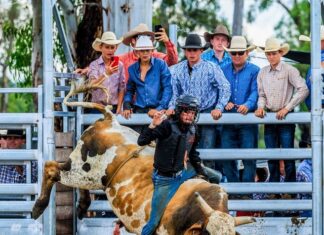Budding scientists from Kindy right through to Year 6 at Bonshaw School have been carrying out water testing and species analysis on the Dumaresq River.
The Bonshaw students recently took an excursion to the Bonshaw Weir to conduct a series of tests on the Dumaresq to determine if the river is supporting a healthy aquatic ecosystem.
After a quick lesson in using the water sampling equipment with Iestyn Taylor from the Border Rivers-Gwydir CMA, the school kids were transformed into enthusiastic river scientists.
Their tests included water pH (how acidic or alkaline), turbidity (how dirty), and electrical conductivity (how salty). The students then compared their results to water quality guidelines, and were pleased to conclude that the Dumaresq is a healthy river.
Swapping the technical equipment for buckets and nets, the young scientists’ next research task was to investigate aquatic life, including waterbugs (macroinvertebrates) which provide food for native water rats and fish.
Iestyn Taylor says you can tell a lot about the health of a river system by looking at its waterbugs, “During our investigations, one young scientist found the curious Caddisfly larvae, which live in cases made from sticks, reeds and sand, which they weave together from silk they produce,” said Mr Taylor.
“Caddisfly larvae are relatively sensitive to poor quality water, so healthy populations of them only occur where the water quality is good.
“Unfortunately for our native fish, waterbugs and frogs, one student scientist also netted the fish species Gambusia or Plague Minnow. These pesky little fish, along with Carp, are the ferals of our river systems. Gambusias are known to attack, kill and eat small native fish, water bugs, frog eggs and tadpoles. They should never be released into waterways, including fish ponds and farm dams as, once in a waterway, they are almost impossible to remove.”
Despite the presence of Gambusia and Carp, the kids at Bonshaw report that native fish such as Yellowbelly and Murray Cod are common in the local rivers.
“For these species to survive it is important to ensure water quality remains good and that they have lots of good habitat to use as protection from the feral fish,” explained Mr Taylor.
“The budding Bonshaw scientists had fun and gained new knowledge while on their research trip to the Bonshaw Weir.
“Heading back to school and transforming into Bonshaw School students once again, the kids will now be able to spread the word to friends and family about the healthy ecosystems of the Dumaresq River,” explained Mr Taylor.
If your local school would like to get involved in a student water testing program, contact Kelly Coleman at the Border Rivers-Gwydir Catchment Management Authority on 02 6728 8020.





